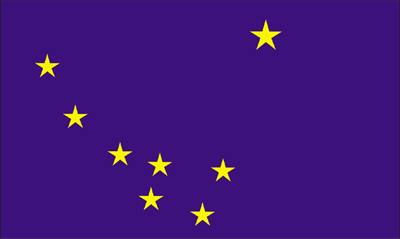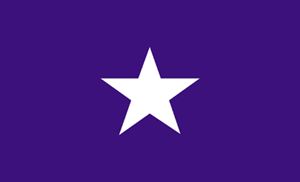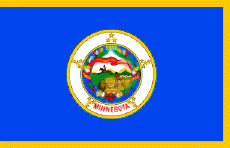The history of your state flag. See what you can learn about yours here.

DESCRIPTION:

During America's Civil War, Wisconsin troops were requesting a flag to carry, but the state didn't have one.

 Subsequently, the legislature formed a committee, and charged them with the development of "a proper state flag." That action resulted in the adoption of Wisconsin's official flag in 1863.
Subsequently, the legislature formed a committee, and charged them with the development of "a proper state flag." That action resulted in the adoption of Wisconsin's official flag in 1863.

 In 1913, the flag was changed, specifying a dark blue background with the state coat of arms centered. The flag remained unchanged until 1980, when the legislature was asked to change the flag so it would appear more distinctive, and be easier to recognize.
In 1913, the flag was changed, specifying a dark blue background with the state coat of arms centered. The flag remained unchanged until 1980, when the legislature was asked to change the flag so it would appear more distinctive, and be easier to recognize.

 They added the word "Wisconsin" and the statehood date in "1848" in white letters, centered below the coat of arms.
They added the word "Wisconsin" and the statehood date in "1848" in white letters, centered below the coat of arms.

DESCRIPTION:

The New Jersey flag originated in 1787, and with the centered seal, was officially adopted in 1896.

 The flag's field is a light, yellow (or buff) color. It was personally selected by General George Washington in 1779, and worn as a uniform color by his New Jersey Continental Line troops in the Revolutionary War.
The flag's field is a light, yellow (or buff) color. It was personally selected by General George Washington in 1779, and worn as a uniform color by his New Jersey Continental Line troops in the Revolutionary War.

 The centered blue shield features three plows, the head armor of a knight, and a horse's head above.
The centered blue shield features three plows, the head armor of a knight, and a horse's head above.

 The two women (right and left) represent the goddesses of Liberty and Agriculture.
The two women (right and left) represent the goddesses of Liberty and Agriculture.

 The blue ribbon (bottom) includes 1776 (the year of independence) and the states's motto - Liberty and Prosperity.
The blue ribbon (bottom) includes 1776 (the year of independence) and the states's motto - Liberty and Prosperity.

DESCRIPTION:

The current version of Michigan's state flag was officially adopted in 1911. It displays (on a dark blue field), the 1832 state arms representation.

 Those arms include an elk and moose supporting the official shield. That shield displays a man indicating friendship. He stands on a peninsula, next to a lake, with the morning sun rising. A bald eagle sits on top of the shield.
Those arms include an elk and moose supporting the official shield. That shield displays a man indicating friendship. He stands on a peninsula, next to a lake, with the morning sun rising. A bald eagle sits on top of the shield.

 Three mottos are included: "E Pluribus Unum" (From Many, One), "Tuebor" (I Will Defend), and "Si Quaeris Peninsulam Amoenam Circumspace" (If you seek a pleasant peninsula, look about you).
Three mottos are included: "E Pluribus Unum" (From Many, One), "Tuebor" (I Will Defend), and "Si Quaeris Peninsulam Amoenam Circumspace" (If you seek a pleasant peninsula, look about you).
To: Cagey; Larry Lucido; rintense
To: MotleyGirl70
Though I am a native Virginian and fiercely proud of it, I've always loved the state flag of my former home of South Carolina.

I don't remember where the crescent moon came from, but the story behind the palmetto tree on the flag came from the defense of Sullivan's Island (near Charleston) against the British during the Revolution. The fort on the island was built from palmetto logs, and the spongy palmetto wood absorbed the impact of the shots fired from British ships offshore, enabling the fort to survive and drive off a British fleet.
}:-)4
4 posted on
07/09/2006 5:41:49 PM PDT by
Moose4
(Dirka dirka Mohammed jihad.)
To: MotleyGirl70
Very cool!
However, I think the "Liberty and Prosperity" on the New Jersey flag should be updated to something like "Corruption and High Taxes".
6 posted on
07/09/2006 5:44:25 PM PDT by
Cagey
To: MotleyGirl70

"This distinctive flag was officially adopted in 1925 and features the sun symbol of the Zia Pueblo Indians. The colors (yellow and red) were the official colors of Queen Isabella of Spain, brought to North America during the Spanish colonial era."
From the website
Addition;
The yellow field and red symbol colors are the colors of Spain. First brought to New Mexico by Spanish explorers in 1540. On New Mexico's flag we see a red sun with rays streching out from it. There are four groups of rays with four rays in each group. This is an ancient sun symbol of a Native American people called the Zia. The Zia believed that the giver of all good gave them gifts in groups of four. These gifts are: * The four directions - north, east, south and west. * The four seasons - spring, summer, fall and winter. * The day - sunrise, noon, evening and night. * Life itself - childhood, youth, middle years and old age. All of these are bound by a circle of life and love, without a beginning or end.
To: Pharmboy
I think you'll enjoy this.
It was personally selected by General George Washington in 1779, and worn as a uniform color by his New Jersey Continental Line troops in the Revolutionary War.
9 posted on
07/09/2006 5:56:10 PM PDT by
Cagey
To: Pharmboy
10 posted on
07/09/2006 5:56:22 PM PDT by
NonValueAdded
(Go home and fix Mexico)
To: MotleyGirl70

In 1926, when Alaska was still a territory, this striking flag was designed by an Indian student. It displays the Big Dipper and the North Star, The gold color of the stars represents the state's enormous mineral resources.
From the website.
My addition.
Alaska adopted the flag for official state use in 1959. The blue field represents the sky, the sea, and mountain lakes, as well as Alaska's wildflowers. Emblazoned on the flag are eight gold stars: seven from the constellation Ursa Major, or the Big Dipper. The eighth being the North Star, representing the northern most state. Alaska's flag was designed in 1926 by a 13-year-old Native American boy, Bennie Benson, from the village of Chignik. Bennie received a 1,000-dollar scholarship and a watch for his winning entry in the flag design contest
http://www.50states.com/flag/akflag.htm
To: Howlin; onyx; Clemenza; Petronski; GummyIII; SevenofNine; martin_fierro; veronica; EggsAckley; ...
To: MotleyGirl70

On June 14, 1846, a small band of settlers marched on the Mexican garrison at Sonoma and took the commandant, Mariano Vallejo, prisoner, They issued a proclamation which declared California to be a Republic independent of Mexico. This uprising became known as the Bear Flag Revolt after the hastily designed flag depicting a grizzly bear and a five pointed star over a red bar and the words "California Republic." The grizzly bear was a symbol of great strength while the lone star made reference to the lone Star of Texas.
The flag only flew until July 9, 1846 when it was learned that Mexico and the United States were already at war. Soon after, the Bear Flag was replaced with the American flag. It was adopted as the State Flag by the State Legislature in 1911.
15 posted on
07/09/2006 6:10:18 PM PDT by
annie laurie
(All that is gold does not glitter, not all those who wander are lost)
To: MotleyGirl70
Nope. I haven't the foggiest idea. I barely even know what it looks like.
16 posted on
07/09/2006 6:12:04 PM PDT by
pcottraux
(It's pronounced "P. Coe-troe.")
To: MotleyGirl70
18 posted on
07/09/2006 6:14:45 PM PDT by
trussell
(Work for God...the retirement benefits are awesome!)
To: MotleyGirl70
Confederate Flags
Bonnie Blue
First raised in 1810 over the fort of Baton Rouge, Louisiana, by a band of Florida troops, the Bonnie Blue served as the symbol of southern independence, and as the official flag of the Confederacy, until it was replaced by the Stars and Bars in 1861. dot dot The Bonnie Blue was used by the Republic of Texas from 1836 to 1839. In 1861, it flew over the capital building in Jackson, Mississippi, inspiring the southern patriotic song - "The Bonnie Blue Flag," composed by Harry MaCarthy. It was also used in one form or another by numerous southern confederate states.
To: MotleyGirl70

Minnesota's official flag was adopted in 1893. The flag has a blue background. The central seal pictures a farmer plowing a field and an Indian riding a horse toward the sun. The scene is surrounded by ladyslippers, Minnesota's state flower. A red banner with yellow letters has the state motto, "L'ETOILE DU NORD," meaning "the star of the north" in French. Three dates are on the flag: 1858 (at the top), the year Minnesota became a state; 1819 (at the left), the year Fort Snelling was established; and 1893 (at the right), the year this flag was adopted. Nineteen yellow stars surround the seal on a white band; these stars symbolize that fact Minnesota was the 19th state to enter the union after the first 13. "MINNESOTA" is written in red on the white band.
22 posted on
07/09/2006 6:22:12 PM PDT by
NordP
(The NEW YORK TIMES - All The News Jihadists Can Use! .....(RL 06/28/06))
To: MotleyGirl70
Did you know the District of Columbia has it's own flag?
District of Columbia Flag

DESCRIPTION:
In the early 1900s, Washington, D.C., had no official flag so a government commission was formed in 1920 to find a design. The design group was headed by A. E. Dubois.
The final design was approved on October 15, 1938, and it was based on the shield from George Washington's family coat of arms.
To: MotleyGirl70
well they got the Indiana one wrong, lol

versus

39 posted on
07/10/2006 7:49:08 PM PDT by
fnord
(497 1/2 feet of rope ... I just carry it)
FreeRepublic.com is powered by software copyright 2000-2008 John Robinson



 Subsequently, the legislature formed a committee, and charged them with the development of "a proper state flag." That action resulted in the adoption of Wisconsin's official flag in 1863.
Subsequently, the legislature formed a committee, and charged them with the development of "a proper state flag." That action resulted in the adoption of Wisconsin's official flag in 1863. 
 In 1913, the flag was changed, specifying a dark blue background with the state coat of arms centered. The flag remained unchanged until 1980, when the legislature was asked to change the flag so it would appear more distinctive, and be easier to recognize.
In 1913, the flag was changed, specifying a dark blue background with the state coat of arms centered. The flag remained unchanged until 1980, when the legislature was asked to change the flag so it would appear more distinctive, and be easier to recognize. 
 They added the word "Wisconsin" and the statehood date in "1848" in white letters, centered below the coat of arms.
They added the word "Wisconsin" and the statehood date in "1848" in white letters, centered below the coat of arms. 


 The flag's field is a light, yellow (or buff) color. It was personally selected by General George Washington in 1779, and worn as a uniform color by his New Jersey Continental Line troops in the Revolutionary War.
The flag's field is a light, yellow (or buff) color. It was personally selected by General George Washington in 1779, and worn as a uniform color by his New Jersey Continental Line troops in the Revolutionary War. 
 The centered blue shield features three plows, the head armor of a knight, and a horse's head above.
The centered blue shield features three plows, the head armor of a knight, and a horse's head above. 
 The two women (right and left) represent the goddesses of Liberty and Agriculture.
The two women (right and left) represent the goddesses of Liberty and Agriculture. 
 The blue ribbon (bottom) includes 1776 (the year of independence) and the states's motto - Liberty and Prosperity.
The blue ribbon (bottom) includes 1776 (the year of independence) and the states's motto - Liberty and Prosperity. 


 Those arms include an elk and moose supporting the official shield. That shield displays a man indicating friendship. He stands on a peninsula, next to a lake, with the morning sun rising. A bald eagle sits on top of the shield.
Those arms include an elk and moose supporting the official shield. That shield displays a man indicating friendship. He stands on a peninsula, next to a lake, with the morning sun rising. A bald eagle sits on top of the shield. 
 Three mottos are included: "E Pluribus Unum" (From Many, One), "Tuebor" (I Will Defend), and "Si Quaeris Peninsulam Amoenam Circumspace" (If you seek a pleasant peninsula, look about you).
Three mottos are included: "E Pluribus Unum" (From Many, One), "Tuebor" (I Will Defend), and "Si Quaeris Peninsulam Amoenam Circumspace" (If you seek a pleasant peninsula, look about you).




 DESCRIPTION:
DESCRIPTION: 


